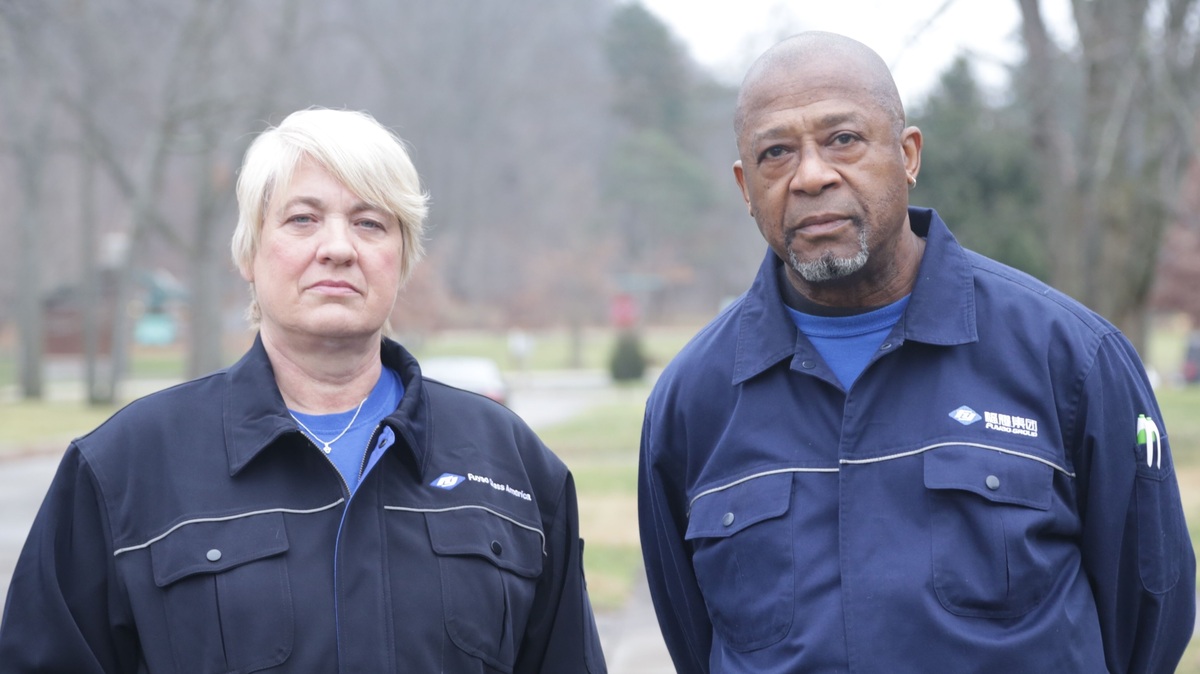Art Clip of Farm and Factory on the Other Side

American workers Jill Lamantia and Bobby Allen struggle to adapt to the expectations of Chinese management in the documentary American Mill. Steven Bognar /Netflix hide explanation
toggle caption
Steven Bognar /Netflix

American workers Jill Lamantia and Bobby Allen struggle to adapt to the expectations of Chinese management in the documentary American Manufacturing plant.
Steven Bognar /Netflix
In the 1960s, there was a terrific one-act in which a teenage Maoist scrawls a flake of graffiti that would get famous: "China IS NEAR." One-half a century on, China is here. Information technology'due south hither on our screens, where Hong Kong protests domination by the Communist mainland. It's here in the tariff war between President Trump and Chairman Xi. And, of form, it's here within the cell phones we all worship.
China's arrival in the American workplace is the subject of a fine new Netflix documentary American Factory by Julia Reichert and Steven Bognar, who've spent years chronicling bluish-neckband lives. Set on the outskirts of their home city of Dayton, Ohio, this measured, securely moving motion picture takes a familiar idea — the notion of an American manufacturing plant — and shows how tricky that concept has become in today's globalized economy.
The story begins with a 2008 prologue in which General Motors shutters its Moraine, Ohio, plant, chucking two,400 union workers out of work and into years of desperate struggle. And so, in 2015, comes hope. The Chinese visitor Fuyao, which makes drinking glass for automobiles, decides to reopen the plant and hire ane,000 locals. Led by its self-fabricated billionaire possessor, Chairman Cao Dewang, Fuyao brings along 200 experienced Chinese employees to oversee production.
At first, the picture shows things going OK. True, a worker like Shawnea Rosser is making only $12.84 an hr, manner down from the $28 she earned at GM. And truthful, the Chinese are frustrated that the Americans work and so slowly — "They accept fat fingers," one says. Still, everyone wants the mill to succeed. Furnace supervisors like Rob Haerr and Wong He become friends, while others seek to sympathize their cultural differences. When it comes to work, these are profound.
We see this in 2 contrasting Fuyao celebrations. In the get-go, a few Ohio workers wing to China and watch the company's New Year festivities, a heavily scripted display of totalitarian kitsch, complete with dancing girls and little kids singing nigh teamwork and corporate success. The 2nd is the American factory's opening ceremony, at which Ohio senator Sherrod Brown startles and enrages Cao and his American execs past saying he hopes the plant volition be unionized. If y'all think American capitalists don't similar unions, effort the Chinese Communists.
While Americans wait 8-hour days with vacations and benefits, Fuyao direction is used to Chinese employees who work 12-hour shifts, with ane 24-hour interval off a month, oft sharing dorm-similar apartments. The bosses think Americans lazy for talking on the job. Meanwhile, the Americans grow dispirited by the relentless manufacturing plant regimen.
Reichert and Bognar are clearly on the side of the workers, both American and Chinese, notwithstanding their picture is no Michael Moore polemic. It's an one-time-school observational documentary in the very best sense of the term. They don't arroyo the Fuyao story with a thesis, don't dehumanize the Chinese, don't tell us what to think. Working with 1,200 hours of footage — heroically edited by Lindsay Utz — they take amazing access to a complex economic reality that is touchingly hard on workers.
Eventually, many of Fuyao'south American workers get fed upwardly with the factory's cramped, hectoring conditions. I won't say what happens, but watching events play out is an educational activity in the workings of the global economy. From the factory floor to the boardroom, everyone is defenseless in the logic of the market, which defines everything in terms of the bottom line. If you lot don't help maximize profit, you lot're gone. We're not surprised when Cao starts to replace his workers with robots.
Reichert and Bognar capture a reality facing millions of Americans. Fifty-fifty equally their wages become down and they long for the comfortable lives folks similar them once could afford, workers in China — whose low pay has driven downward wages all over the Western world — enjoy a prosperity they've never known. Life's looking rosier for them. Their 12-hour work-day, without time off or benefits, represents the rise model of labor in 21st century commercialism.
Most the end of American Factory, Chairman Cao strolls outside a glassy, pillared mansion that contains what looks like a shrine to himself. "The point of living is to piece of work," he says. "Don't you lot think so?" It's difficult to call back of a sadder, or scarier, line in any movie this yr.
maxwell-mahontomentioun1947.blogspot.com
Source: https://www.npr.org/2019/08/23/753109643/work-cultures-clash-when-a-chinese-company-reopens-an-american-factory
0 Response to "Art Clip of Farm and Factory on the Other Side"
Post a Comment